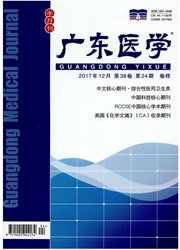

 中文摘要:
中文摘要:
目的通过流式细胞染色方法研究慢性乙型肝炎患者外周血CXCR5+CD4+T细胞亚型,比较两种不同的染色缓冲体系对分析细胞表型和细胞内转录因子染色结果的影响。方法用流式细胞术检测Fox P3 buffer(FB)染色和Transcription factor buffer(TB)染色人外周血活淋巴细胞频数占总细胞的比例(即活力),CXCR5^+CD4^+T细胞表型分子CD4、CXCR5、GITR表达百分比(即免疫表型),及其转录因子Fox P3表达百分比(即转录因子)。结果 FB和TB染色法淋巴细胞活力差异无统计学意义;与TB染色法比较,FB染色法测得的表型分子(CD4、CXCR5、GITR)阳性细胞频数显著降低(P〈0.05);与TB染色法比较,FB染色法测得的转录因子(Fox P3)阳性细胞频数显著增高(P〈0.01)。结论两种流式细胞染色方法对CXCR5^+CD4^+T细胞表型分子及转录因子的染色比例存在差异,同时检测CXCR5^+CD4^+T细胞表型和转录因子时需要对反应体系进行优化。
 英文摘要:
英文摘要:
Objective The aim of the study was to investigate the impact of two flow cytometry staining protocols for the phenotype and transcription factor detection of peripheral CXCR5^+CD4^+T cell subsets in patients with chronic hepatitis B. Methods The ratio of living lymphocytes( dynamic) and the expression of CD4,CXCR5,GITR( phenotypes)and Fox P3( transcription factor) were detected by flow cytometry after stained by Fox P3 buffer( FB) and transcription factor buffer( TB),respectively. Results There was no significant difference in the dynamic of living lymphocytes between FB and TB staining methods. There were significant differences in the percenteae of the phenotypes( higher with TB) and the transcription factor between two methods( higher with FB)( P〈0. 05). Conclusion It is suggested that the different protocols of flow cytometry staining affect the analysis of the phenotype and transcription factor of peripheral CXCR5^+CD4^+T cell subsets. Optimization experiment is necessary during the simultaneous analysis of the phenotype and transcription factor.
 同期刊论文项目
同期刊论文项目
 同项目期刊论文
同项目期刊论文
 期刊信息
期刊信息
